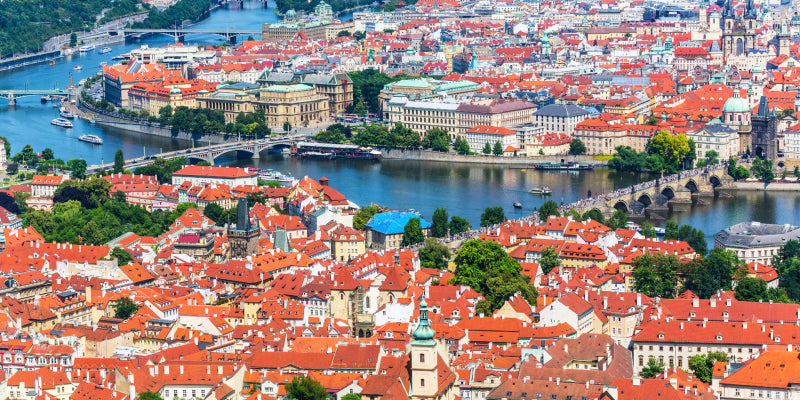Prague is a city full of distinction and uniqueness. Nestled between the banks of the River Vltava on one side and thick wooded hills to the other, there is a definite historical feel to Prague. It has managed to survive over 600 years without losing its unique architecture to wars or natural disaster, which is why Prague has managed to retain its medieval layout and character despite development projects during the postwar period. Enveloped in a rich tapestry of Baroque and medieval designs and elements, Prague has become one of the most popular city break locations in Europe and offers delights to tourists from all over the world. You will not want to miss these top places to visit in Prague upon your first trip to this breathtaking city.
Pražský hrad (Prague Castle)
 Prazsky hrad, otherwise known as Prague Castle, dominates the skyline when you look at it from the Charles Bridge. This is the image that most tourists see when they start looking at pictures of Prague – a strikingly powerful looking castle despite the rather sober regal edifice, sheltered by a somewhat blank wall. At night, the castle is lit up dramatically for the entire world to see, embellishing its striking character.
Prazsky hrad, otherwise known as Prague Castle, dominates the skyline when you look at it from the Charles Bridge. This is the image that most tourists see when they start looking at pictures of Prague – a strikingly powerful looking castle despite the rather sober regal edifice, sheltered by a somewhat blank wall. At night, the castle is lit up dramatically for the entire world to see, embellishing its striking character.
The castle was born way back in the 9th century, but very little of the original castle actually survives. Most of what you see today can be attributed to two architects – Nicolo Pacassi, who was in the employ of Empress Maria Theresa. He restored the castle in a rather serious manner which led to its demise and eventual usage as an administrations barracks. His work has been considered unpardonable. The next architect to make his mark on the castle was Slovene Josip Plecnik. He was hired by T. G. Masaryk, the president of the Czechoslovak Republic, during the 1920s to give the castle a more contemporary feel.
Touring the castle equals a tour around history itself. There are various rooms open to the public, but make sure that you visit the initial courtyard where two Battling Titans, two gigantic statues standing on both gate piers holding clubs and daggers, ready to strike mortal blows to their enemies, watch over protectively. You should also try to see the Changing of the Guard, which happens every hour, with the parade at noon being extra fun to watch.
Pass through the early Baroque Matyasova brana (known in English as Matthias Gate) in order to visit the second courtyard. The Matthias Gate was originally erected as a triumphal arch that was situated in the middle of the moat but now is incorporated into a blank wall. Either way, it is quite striking to look at.
Malá Strana
As though protecting it like a mother would overlook her child, lays the Little Quarter known as Mala Strana. This is a photo worthy area, full of cobbled little streets which have been untouched for centuries. This was the area that Mozart would frequent regularly when he would visit Prague between 1787 and 1791. The Little Quarter is certainly little, an area roughly 600 square meters, but its big personality draws even bigger crowds. Here you will find gorgeous little terraced gardens, the Church of sv Mikulas and the Kampa Museum, all of which are well worth exploring.
Karlův most (Charles Bridge)
 Charles Bridge, also known as Karluv most, was the only way people could visit the other half of Prague, which was divided by the river. It is an icon of the city and an extraordinary aspect of engineering from the medieval era. The entrance to the Charles Bridge is guarded by two large Gothic gateways but there are several statues from the Baroque period which line the length of the bridge. Coupled with the sight of the Prague Castle in the background, the Charles Bridge is certainly an impressive iconic aspect of the city.
Charles Bridge, also known as Karluv most, was the only way people could visit the other half of Prague, which was divided by the river. It is an icon of the city and an extraordinary aspect of engineering from the medieval era. The entrance to the Charles Bridge is guarded by two large Gothic gateways but there are several statues from the Baroque period which line the length of the bridge. Coupled with the sight of the Prague Castle in the background, the Charles Bridge is certainly an impressive iconic aspect of the city.
The river had been known to flood quite regularly and when it burst its banks and swept the original bridge away in 1342, a new one was commissioned by Charles IV through the German architect, Peter Parler. Work commenced in 1357 but wasn’t finished until the 15th century. Until 1870 the bridge was known as the Prague Bridge or the Stone Bridge, and then it was renamed after Charles IV. The Charles Bridge is extremely popular with tourists and locals alike, gathering here at all times of the day and night. The views from the bridge are truly out of this world when the moon and the stars stain the night sky.
Prague Orloj (The Prague Astronomical Clock)
 Located in the Old Town Square, the Orloj is a magnificent astronomical clock that was installed in 1410, making it the oldest working astronomical clock in the world. The clock has a daily show on the hour called “The Walk of the Apostles”, complete with a figure of Death, which is represented by a skeleton, striking the time. It truly is a must-see on your trip to Prague.
Located in the Old Town Square, the Orloj is a magnificent astronomical clock that was installed in 1410, making it the oldest working astronomical clock in the world. The clock has a daily show on the hour called “The Walk of the Apostles”, complete with a figure of Death, which is represented by a skeleton, striking the time. It truly is a must-see on your trip to Prague.
 Prague is a city full of delights waiting for you to explore them. Walking the streets allows you to experience a city that is extremely proud of its rich and intricate history, one that has a culture and identity that fascinates tourists from all over the world. Extremely popular with holiday makers from all over the globe, a trip to Prague equals a trip unlike no other. When you return, be sure to mark your favorite sites on an Executive World Travel Map.
Prague is a city full of delights waiting for you to explore them. Walking the streets allows you to experience a city that is extremely proud of its rich and intricate history, one that has a culture and identity that fascinates tourists from all over the world. Extremely popular with holiday makers from all over the globe, a trip to Prague equals a trip unlike no other. When you return, be sure to mark your favorite sites on an Executive World Travel Map.
The post A City Guide to Prague, Czech Republic appeared first on Push Pin Travel Maps.


Share:
Ten Free Things to Do in Hong Kong
Angkor Wat Visitors Guide